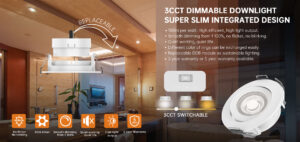Lighting plays a crucial role in our daily lives, affecting everything from how we see our environment to how comfortable and productive we feel. Yet, the technical terms used to describe light—lumen, lux, og candela—often cause confusion, even among professionals in the lighting industry.
Understanding these units is essential for selecting the right lighting solutions, whether for residential, commercial, or specialized applications. This article offers a comprehensive explanation of lumen, lux, and candela, highlighting their differences, practical uses, and how they interrelate. By the end, you will be equipped to make informed decisions about lighting products and designs, especially in the context of European markets.
What Is Lumen?
Lumen (lm) is a measure of the total amount of visible light emitted by a source. It quantifies the overall brightness perceived by the human eye from a light bulb or fixture. When you see a light bulb’s packaging indicating lumens, it tells you how much light the bulb produces in total, regardless of direction.
Lumens are critical when comparing the brightness of different light sources. For example, a 10-watt LED bulb producing 800 lumens will be much brighter than a 5-watt LED emitting 400 lumens. Lumens help consumers understand the total light output, which is especially useful for general lighting purposes.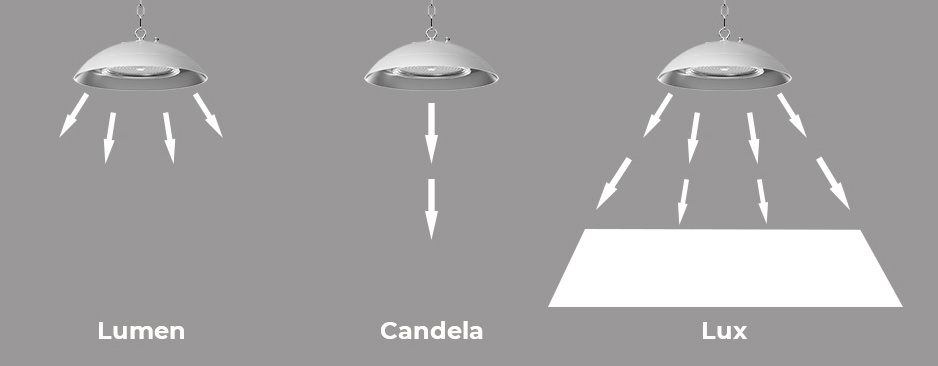
However, lumens do not indicate how that light is distributed or how bright a specific surface will appear. For instance, a high-lumen floodlight can illuminate a large outdoor area, but the light intensity on any single spot may be low if the light spreads widely.
What Is Lux?
Lux (lx) measures the intensity of light on a specific surface area. It is defined as one lumen per square meter. Lux tells you how well-lit a particular area or object is, making it a practical metric for assessing lighting quality in a room or workspace.
For example, a desk lamp might emit 500 lumens, but the lux value on your desk depends on the distance and angle of the light. If the lamp is close to the desk, the lux level will be high, indicating a bright working surface. If the lamp is farther away, the lux level decreases because the same amount of light spreads over a larger area.
Lux is especially important in environments where precise lighting is needed, such as offices, classrooms, or hospitals. European lighting standards often specify minimum lux levels for different settings to ensure safety and comfort. For detailed standards and measurement protocols, refer to the IES Lighting Library Standards Collection (2025).
What Is Candela?
Candela (cd) measures the luminous intensity of a light source in a particular direction. It describes how concentrated the light is along a specific beam, rather than the total amount of light emitted.
Candela is useful for understanding the focus of a light beam, such as in spotlights or flashlights. A high-candela rating means the light is intense and focused, suitable for highlighting objects or areas. For example, a spotlight with a high candela value directs a bright, narrow beam, while a floodlight with a lower candela value spreads light broadly but less intensely.
One candela is equivalent to approximately 12.57 lumens distributed uniformly over a sphere. However, because candela and lumens measure different aspects—intensity versus total output—they cannot be directly compared without context.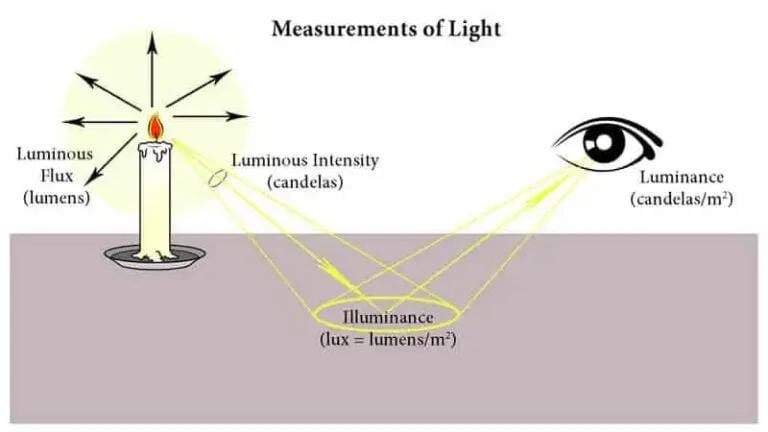
Principles and Calculations of Lumen, Lux, and Candela
Lumen: Total Light Output
Lumen measures the total luminous flux, or the overall amount of visible light emitted by a source in all directions. It is calculated by summing the light energy visible to the human eye across the entire emission sphere.
- Formula: Lumens (Φv) are often given directly by manufacturers based on photometric testing.
- For a light source emitting uniformly in all directions, the relationship between lumens and candela is:
Lumens = Candela × Ω
hvor Ω is the solid angle in steradians over which the light is emitted. For a full sphere, Ω = 4π ≈ 12.57 sr.
If the light source emits in a cone with apex angle θ, the solid angle is:
Ω = 2π × (1 – cos(θ/2))
Thus,
Lumens = Candela × 2π × (1 – cos(θ/2))
This formula allows conversion between luminous intensity (candela) and total luminous flux (lumens), depending on the beam spread.
Lux: Illuminance on a Surface
Lux measures the illuminance, or how much luminous flux falls on a surface per unit area.
- Formula:
Lux = Lumens / Surface Area (m²)
This means if 800 lumens fall evenly on a 2 m² desk, the illuminance is 400 lux.
Lux depends heavily on the distance between the light source and the surface. As the distance increases, the same amount of light spreads over a larger area, reducing lux.
Lux can also be related to candela and distance d (in meters) by:
Lux = Candela / d²
This formula assumes the light is focused in a specific direction and the surface is perpendicular to the light beam.
Candela: Luminous Intensity in a Direction
Candela measures the luminous intensity, or how much light is emitted in a particular direction per unit solid angle.
- Formula:
Candela = Lumens / Ω
hvor Ω is the solid angle in steradians.
For example, a bulb emitting 800 lumens uniformly in all directions (solid angle 4π) has:
Candela = 800 / 4π ≈ 63.66 cd
Candela is crucial for understanding how focused or directional a light source is.
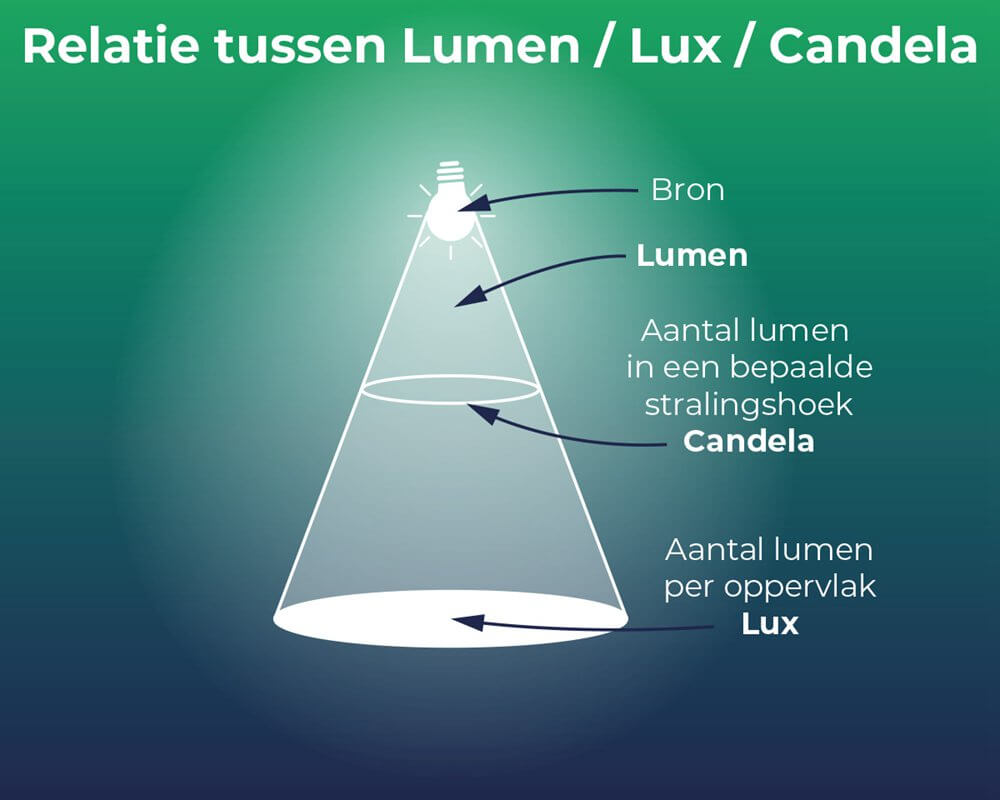 Connection and Differences Between Lumen, Lux, and Candela
Connection and Differences Between Lumen, Lux, and Candela
- Lumen quantifies the total visible light emitted by a source, regardless of direction.
- Lux measures how much light actually illuminates a surface area, dependent on distance and distribution.
- Candela expresses the light intensity in a specific direction, reflecting how focused the beam is.
They are interconnected: lumens describe total output, candela describes directional intensity, and lux describes surface illumination.
For example, a spotlight with a narrow beam angle has a high candela value but may have fewer lumens overall compared to a broad floodlight. The lux on a surface depends on both the candela and the distance from the source.
| Parameter | Measures | Unit Definition | Depends On | Typisk brug |
|---|---|---|---|---|
| Lumen | Total light output | Total luminous flux (lm) | Light source power and efficiency | Overall brightness of bulbs |
| Lux | Illuminance on surface | Lumens per square meter (lm/m²) | Distance, beam spread, surface size | Brightness of workspaces or rooms |
| Candela | Luminous intensity in direction | Lumens per steradian (lm/sr) | Beam angle, light focus | Spotlight intensity, beam focus |
Which Parameter Matters Most in Different Lamps and Applications?
General Ambient Lighting
Lumen is the most important parameter. It tells you how bright the room will be overall. For example, LED downlights and ceiling lights are rated primarily by lumens to ensure sufficient ambient brightness.
Task and Accent Lighting
Lux becomes critical because it measures how well a specific surface is lit. Desks, reading areas, or display cases require certain lux levels for comfort and visibility. Adjustable lamps and desk lights focus on achieving recommended lux values.
Directional and Focused Lighting
Candela is key for spotlights, floodlights, and track lighting. It indicates how intense and concentrated the beam is. High candela values mean a narrow, bright beam ideal for highlighting artwork or architectural features.
| Application Type | Most Important Parameter | Reason |
|---|---|---|
| Omgivende belysning | Lumen | Ensures overall brightness in a space |
| Opgavebelysning | Lux | Provides adequate illumination on surfaces |
| Accent/focused lighting | Candela | Controls beam intensity and focus |
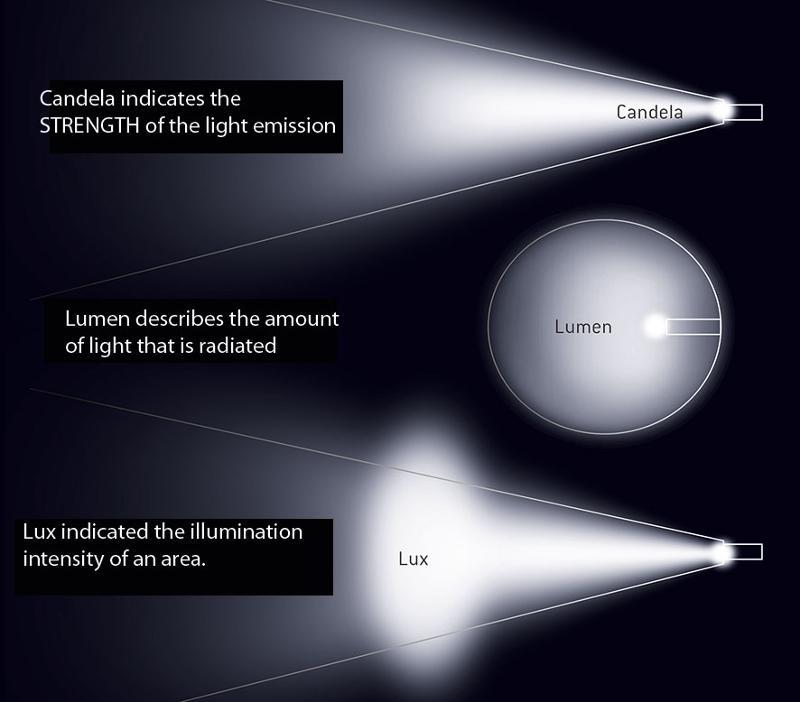 Radians Lighting: Expertise in Custom Lighting Solutions
Radians Lighting: Expertise in Custom Lighting Solutions
Radians Lighting is a leading European manufacturer specializing in high-quality LED lighting solutions tailored to diverse needs. With a strong focus on produkttilpasning, Radians offers bespoke designs that meet specific project requirements, including lumen output, beam angle, and color temperature. Their rigorous production quality control ensures consistent performance and compliance with European standards.
Radians’ product range includes a variety of LED downlights, spotlights, and track lighting systems designed to optimize illumination in residential, commercial, and industrial settings. For instance, their dæmpbare LED downlights and adjustable downlights allow precise control over light intensity and direction, aligning perfectly with the concepts of lumen, lux, and candela discussed here. Customers can explore their extensive catalogue to find solutions that balance brightness, focus, and energy efficiency.
By integrating advanced technology and design expertise, Radians Lighting supports architects, designers, and end-users in creating well-lit environments that enhance comfort and functionality. Their commitment to sustainability and innovation positions them as a trusted partner in the European lighting market.
Practical Examples of Lumen, Lux, and Candela in Lighting Products
| Product Type | Typical Lumen Output | Beam Angle (Degrees) | Candela (Approximate) | Suitable Application |
|---|---|---|---|---|
| 6W LED downlight | 500-600 lm | 60 | 300-400 cd | General ambient lighting in living rooms |
| Justerbar LED-downlight | 700-900 lm | 30-45 | 800-1000 cd | Accent lighting for art or retail displays |
| Dimmable Track Spotlight | 800-1200 lm | 15-30 | 1200-1500 cd | Focused task lighting in offices or galleries |
Konklusion
Sammenfattende, lumen, lux, and candela are fundamental but distinct measurements in lighting that serve different purposes. Lumens quantify the total light output, lux measures the brightness on surfaces, and candela indicates the intensity of light in a specific direction. Understanding these differences is vital for selecting appropriate lighting products and designing effective lighting schemes.
For professionals and consumers alike, grasping these concepts enables better decisions that improve lighting quality, energy efficiency, and user comfort. Companies like Radians Lighting exemplify how expertise in these measurements translates into superior lighting solutions tailored to European market standards.
By applying this knowledge, you can confidently choose lighting that meets your needs, whether for a cozy home, a productive office, or a vibrant commercial space.
For more detailed product information and tailored lighting solutions, visit Radians Lighting’s LED Downlight Collection and explore their full range of customizable options.




